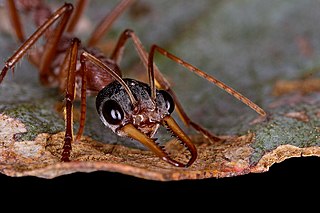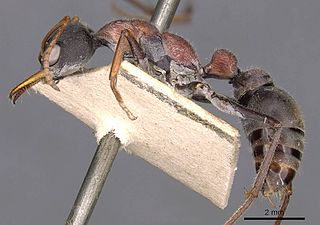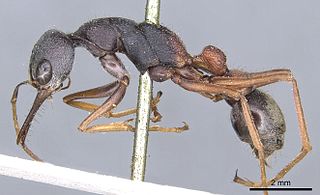
Myrmecia is a genus of ants first established by Danish zoologist Johan Christian Fabricius in 1804. The genus is a member of the subfamily Myrmeciinae of the family Formicidae. Myrmecia is a large genus of ants, comprising at least 93 species that are found throughout Australia and its coastal islands, while a single species is only known from New Caledonia. One species has been introduced out of its natural distribution and was found in New Zealand in 1940, but the ant was last seen in 1981. These ants are commonly known as bull ants, bulldog ants or jack jumper ants, and are also associated with many other common names. They are characterized by their extreme aggressiveness, ferocity, and painful stings. Some species are known for the jumping behavior they exhibit when agitated.

Nothomyrmecia, also known as the dinosaur ant or dawn ant, is an extremely rare genus of ants consisting of a single species, Nothomyrmecia macrops. These ants live in South Australia, nesting in old-growth mallee woodland and Eucalyptus woodland. The full distribution of Nothomyrmecia has never been assessed, and it is unknown how widespread the species truly is; its potential range may be wider if it does favour old-growth mallee woodland. Possible threats to its survival include habitat destruction and climate change. Nothomyrmecia is most active when it is cold because workers encounter fewer competitors and predators such as Camponotus and Iridomyrmex, and it also increases hunting success. Thus, the increase of temperature may prevent them from foraging and very few areas would be suitable for the ant to live in. As a result, the IUCN lists the ant as Critically Endangered.

Myrmecia gulosa, the red bull ant, also known as the giant bull ant or "hoppy joe", is a species of bulldog ant from the genus Myrmecia. It is abundant throughout Eastern Australia.

Myrmecia nigriceps, also known as the black-headed bull ant, is a species of ant endemic to Australia. A member of the genus Myrmecia in the subfamily Myrmeciinae, it was first described by Austrian entomologist Gustav Mayr in 1862. These ants are large, varying from 19 to 23 millimetres in length. However, colonies contain workers that are much smaller, usually half the size of normal workers. The queens are the largest while the males are the smallest, which can be easily identified due to their small mandibles.

Myrmecia pyriformis, also known as the bull ant or inch ant, is an Australian ant. Myrmecia pyriformis belongs to the genus Myrmecia. It is abundant in many major cities of Australia, but mostly spotted in the eastern states. The species is of a similar appearance to the Myrmecia forficata.

Myrmecia arnoldi is a bull ant of the genus Myrmecia. Like all bull ants except for one species in this genus, Myrmecia arnoldi is native to Australia.

Myrmecia gratiosa is an Australian ant which belongs to the genus Myrmecia. Native to Australia, this species is mainly found in Western Australia. During a study in Perth, it was realised that Myrmecia gratiosa was located in all locations where reactions in patients occurred. This concludes the species was responsible for ant sting anaphylaxis around Perth.

Myrmecia harderi is an Australian bull ant species which is part of the genus Myrmecia. They are native to Australia. They are mainly distributed in New South Wales, and some parts of Victoria, South Australia, and Queensland.

Myrmecia piliventris, the golden tail bull ant, is an Australian ant which belongs to the genus Myrmecia. This species is native to Australia. The Myrmecia piliventris is distributed Australia wide, but they're not too common in the western regions of Australia.

Myrmecia chasei is an Australian ant which belongs to the genus Myrmecia. This species is native to Australia. The Myrmecia chasei has a large presence and distribution in the south-eastern areas of Western Australia.
Myrmecia fulgida is an Australian ant which belongs to the genus Myrmecia. This species is native to Australia. Their distribution mostly in Western Australia and some areas of the east of Australia.

Myrmecia regularis is a species of ant endemic to Australia. A member of the genus Myrmecia in the subfamily Myrmeciinae, it was first described by American entomologist Walter Cecil Crawley in 1925. These ants are medium to large in size, measuring 10 to 20 millimetres, and they are bright brownish-red in colour. Queens and workers share similar morphological features, but they can be distinguished by the noticeable size difference. Males also look similar, but collected specimens are too damaged to be examined properly.

Myrmecia froggatti is an Australian ant which belongs to the genus Myrmecia. This species is endemic to Australia. This species is distributed throughout all areas of New South Wales and elsewhere up north and south.

Myrmecia fuscipes is an Australian ant which belongs to the genus Myrmecia. This species is native to Australia. Their distribution is heavily observed in South Australia and Western Australia.

Myrmecia athertonensis is an Australian ant which belongs to the genus Myrmecia. This species is endemic to Australia. They are commonly spotted in the north of Queensland. It was described by Forel in 1915.

Myrmecia michaelseni is an Australian ant which belongs to the genus Myrmecia. This species is native to Australia. They are mostly distributed and studied in Western Australia.

Myrmecia occidentalis is a species of ant. It belongs to the genus Myrmecia and was described by John S. Clark in 1943. Native to Australia, Myrmecia occidentalis is mainly distributed in the state of Western Australia.

Myrmecia comata is an Australian ant in the genus Myrmecia. This species is native to Australia and distributed mostly around Queensland. It was described as a species by John S. Clark in 1951.

Myrmecia swalei is an Australian ant which belongs to the genus Myrmecia. This species is native to Australia and is commonly distributed in Western Australia and South Australia. It was described by Crawley in 1922.

Myrmecia varians is an Australian ant which belongs to the genus Myrmecia. This species is endemic to Australia. The Myrmecia varians is one of the most distributed ants in the country, with the species being observed in every single state and territory except for Tasmania. Myrmecia varians was first described by Mayr in 1876.


















